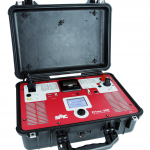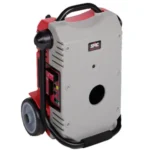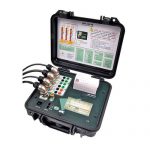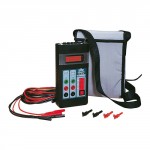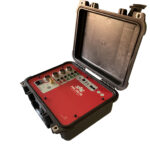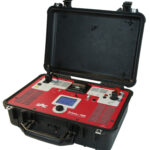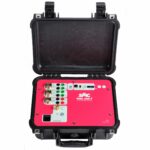Circuit Breaker Testing Solutions
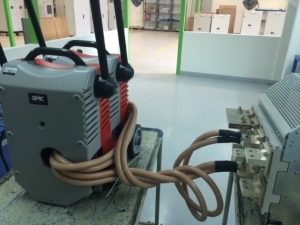
Circuit breakers are very important for the proper function of power supply systems, being responsible for effectively opening and closing the circuit to remove faults and connect/disconnect parts of the network. They are built to withstand considerable static and dynamic workloads during their lifecycle, which can be several decades. They have to perform its duty after months or years of inactivity, therefore the circuit breaker testing is essential to ensure its function properly and optimize network reliability. Circuit breaker testing can be done at various stages in the life of the CB, in production, commissioning, maintenance, fault troubleshooting, etc.
Circuit breaker testing is based on comparison and trending analysis from previous tests that will help predict an abnormal operation before it happens, saving time and money. High measurement accuracy and reliable storage of data is required for circuit breaker testing, but we also emphasize the importance of saving test time – the time that the circuit breaker is out of service is short – minimizing the set up work, connections, and test complexity, for achieving a simplified and faster circuit breaker testing; therefore, test sets with unique combination of features that effectively optimize both the results and the methods are the goal of the SMC solutions for circuit breaker testing.
Description
Related Products
Additional Information about circuit breaker tester
Optimized solutions for the main circuit breaker testing requirements
Close and trip times, synchronism, trip & close coils condition, mechanical motion analysis and status of the DC batteries are the most commonly checked parameters in circuit breaker testing, since a large part of the major failures have mechanical origin. The circuit breaker analyzer PME-500-TR includes all mentioned functions to evaluate the condition of the breaker in an easy to use instrument, PC independent, with just 8 kg, including rechargeable battery. The contact resistance measurement is traditionally obtained from another unit, a microohmmeter, as verification of the contacts are a main requirement in circuit breakers testing, which requires additional time spent with the connections and results are not stored in the same database. The PME-500-TR automatically measures the contact resistance of the three poles with a resolution of 0.1 μΩ, and is included in the same report, which dramatically reduces off-time in circuit breaker testing.
Recently, EuroSMC launched two new devices based on PME-500-TR: the PME-600-T and the PME-700-TR. Both new solutions add wireless control capabilities, remove the printer and screen, and save resources that are valuable for the environment. They also allow control from any laptop or mobile device with a much higher image resolution, and give the possibility to generate direct reports and send them by email. The absence of a screen and printer saves some weight, making the PME-600-T around 5 kg as it does not have a battery either.
When the circuit breaker is in bad shape the static contact resistance values will change dramatically from initial values. Moreover, measuring the dynamic resistance during the opening and closing will indicate the wear of the arcing contacts. Our new PRIME micro-ohmmeter results best-suited for this circuit breaker testing, the only microohmmeter that combines both static and dynamic resistance measurements, as it is essential for assessing the actual condition of the contacts in inaccessible SF or vacuum chambers. PRIME 600 provides true pure DC with smart and easy control up to 600A, including Dual Ground, and wireless remote control. The ideal microohmeter for general circuit breaker testing.
The correct circuit breaker testing of low voltage circuit breakers and molded-case circuit breakers can be performed using primary current injection, as the only means to check the entire functionality. The RAPTOR System, with the smallest size and weight of the market provides the required power and portability for testing the rated MCB/MCCB/ACB´s tripping time performance, both thermal and short-circuit trips. User can complete his results with the multifunctional Raptor, including the contact resistance of each pole, CT ratios, CT excitation curve, check wiring, etc. In the case of MV/HV circuit breaker testing, it is also essential the verification of the entire protection scheme to verify live CB tripping, in combination with total trip time including the IEDs. The combination of mobility, adaptability, automatic output regulation, high-tech, ease of use and versatility makes the Raptor the best system available for all primary injection testing applications in circuit breaker testing.
Other SMC solutions for circuit breaker testing
The Raptor is the first digital high current injection system, non-variac based, but SMC also offers traditional variac-based equipments, the LET units, with a wide choice of power ranges for circuit breaker testing.
Other useful instrument for quick and simple measuring the circuit breaker open and close time is the digital timer PTE-30-CH; this circuit breaker testing does not provide information about the poles synchronization, unlike the most complete info provided by the PME-500-TR.
For miniature circuit breakers, which current requirements are smaller, the wide range of SMC secondary injection test sets are also suitable for this kind of circuit breaker testing (PTE-100-C, PTE range, Mentor 12).
For the circuit breaker testing of MCBs in factories and laboratories, The SMC-12 system, made up to 10 positions of EMU stabilized current sources, is designed to meet the needs established by the international standards for the routine and quality control tests with regards to their thermal and magnetic response.
For more information, please check the related circuit breaker testing products or contact SMC.
For additional Information about circuit breaker tester, see the following contents
- Circuit Breaker Test Equipment: Options in circuit breaker test equipment for different applications. Circuit Breaker Analyzer, Micro-ohmmeters, Primary and Secondary Injection test sets.
- Circuit Breaker tester: Different MV, HV and LV circuit breaker tester options; initial selection keys to choose a suitable circuit breaker tester for every application.
- How to test a circuit breaker: How to test a circuit breaker, initial considerations, and several test equipment for the different applications and types of breakers.

